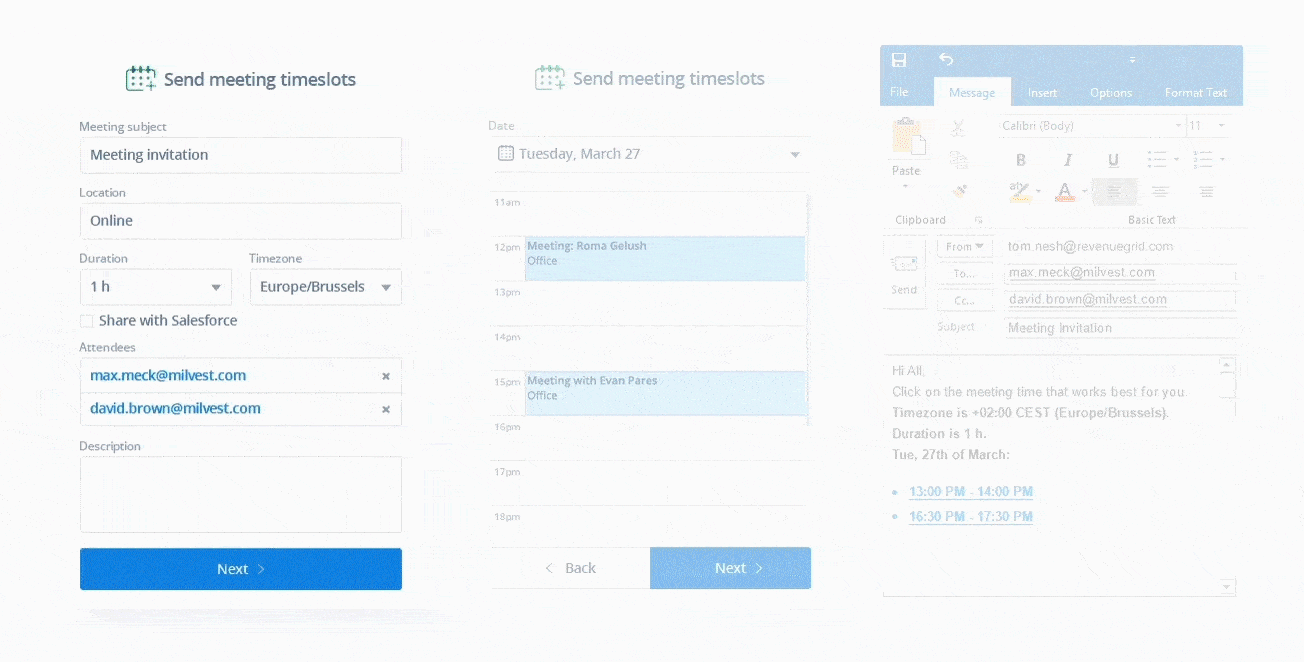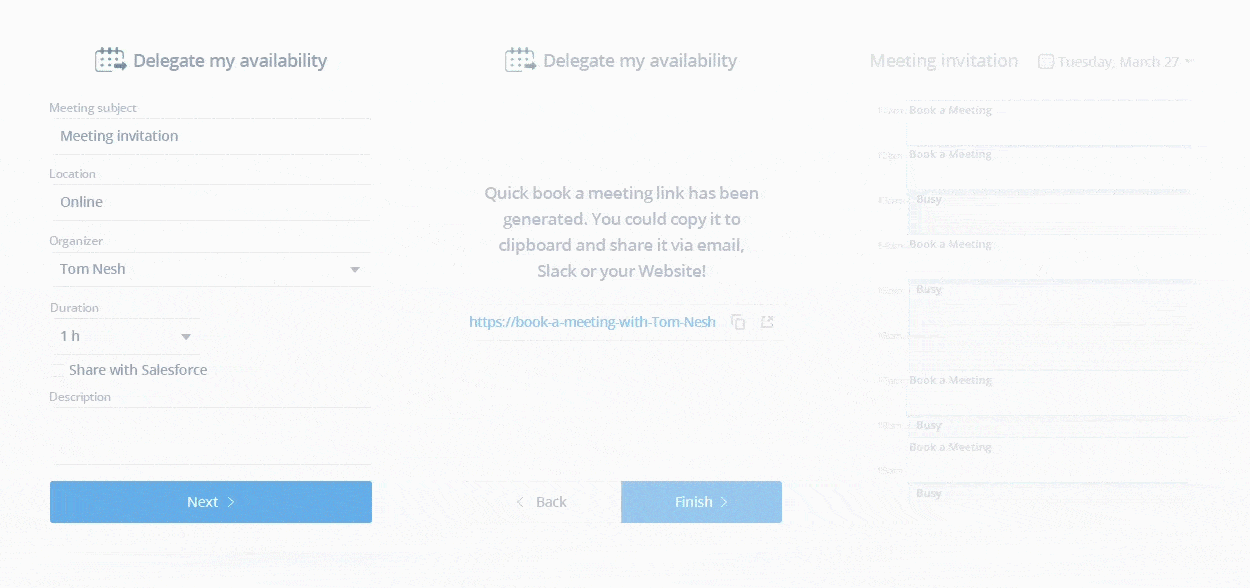Meeting in person with a prospective client can make all the difference when it comes to closing a sale. The personal nature of such an interaction allows parties to better read each others’ body language, bond more closely, and think strategically. These elements give a salesperson much stronger powers of persuasion. In fact, a face to face request for meeting is more than 30 times more likely to get a yes than one via email. Moreover, the close rate for in-person meetings is 40% making this a crucial step in your sales process.
Yet as we are all painfully aware, convincing someone to take part in a traditional meeting is no easy feat! Not only do you need to get that lead’s attention from the get-go, but you need to convince them to take time out of their schedule to actually be somewhere for you. While this may sound like squeezing water from a stone, in fact an effective method is to use email to schedule meetings.
Why use email to schedule meetings?
Email is one of the most convenient and organized forms of correspondence. Unlike texting, calling, or instant messaging on social media, email makes it easy to keep track of messages. In addition to this, there are many other benefits to settling an appointment email:
- Convenient back and forth for discussing time and place without any worry about interruptions to the conversation.
- Both you and the contact can search old messages to refer to details about the meeting.
- Emails for meeting request can contain calendar invites, links to RSVPs, directions, participant lists, and any other relevant information for the meeting.
- Meeting details can easily be transferred from the email to inform meeting schedule to calendar apps.
- There’s a smaller margin of error; less chance of mishearing, bad note-taking, or other miscommunications.
- Assistants and other teammates can be copied which helps with accountability and improved response rate from both sides.
- During correspondence, you can incorporate an email and calendar integration tool such as Revenue Grid to improve the overall effectiveness of your sales process.
Best Solutions from Revenue Grid
How to schedule a meeting by email easier?
Once you’ve scheduled the meeting by email you definitely want it to appear in your CRM calendar. If you have ever missed an important meeting because your Salesforce calendars weren’t in sync on your tablet, laptop, or mobile devices, you understand that one missed meeting can lead to a lost opportunity. In a world where we expect accurate and real-time information at our fingertips, “my calendars didn’t sync” is not a valid excuse.
Future-looking businesses are rightfully investing in a 360-degree view of client and employee interactions through email and calendar synchronization tools to improve their growth, profitability, and retention. If you haven’t started to invest in these resources, there is no better time than now, and the Revenue Grid calendar sync tool is the best place to start.
There are three simple ways how you can schedule a meeting by email in a fast and simple way:
Scheduling a meeting option 1: Share the available calendar slots
When you want to understand how to suggest time for a meeting choose several available slots in your calendar and send them to your prospect. You can also share the link to your full availability and let the prospect define the most suitable time.
See the sample email to request meeting below.

In this meeting request email template the prospect can choose between two time slots to schedule a meeting.
Scheduling a meeting option 2: Give access to your calendar
You can go one step further delegating calendar availability to your prospect. To make this possible, you have to include the personal booking link with access to your calendar in emails to them. Through the link, the prospective lead will choose the most suitable time for meeting with you.
Examine the meeting request email example below.

Scheduling a meeting option 3: Synchronize recurring meetings and emails
If you plan multiple meetings with the same lead during a certain period of time you can eliminate the constant tapping between your CRM and email calendar. You’ll have all your data in one place.
Once you go through all these steps you gain enormous productivity and a harmonious network between your CRM and email client. Interested in seeing the email and calendar integration tool in action?
Schedule your meetings with ease
Schedule your meetings with ease
Use the most intelligent automated nurturing tool for Salesforce (free trial)
What to include in an email setting up a meeting
Naturally, an email to schedule a meeting needs many of the elements present in any sales related email. In general, the meeting request email should be polite, brief, and relevant to the interests of the recipient. Some factors to keep in mind:
- The first hurdle is getting the recipient to open the message! Subject lines should be clear, concise, and engaging. For example, you could write “Request for a meeting,” “Meet during coffee break at X conference,” or “Quick chat about [product/problem] next Wednesday?”
- If you haven’t spoken with the person before, introduce yourself succinctly. Convey the value of a meeting with you.
- Do your research: Have a good understanding of what the client needs. Know where they are in the buying process and their level of interest. Craft a message that addresses their present situation.
- When suggesting a time and a place, be flexible. Offer options; indicate openness to the contact’s suggestions to set up a time for the meeting.
- Include a call to action whenever you can, whether it’s offering multiple choices for meeting dates/times, an RSVP click, or a calendar response.
There are a few other more specific tactics to incorporate that will make your email meeting requests markedly more compelling. Let’s delve into them and see some email templates to schedule meetings.
Meeting request email samples
Email example: Standard meeting request with someone you know
An ideal email setting up a meeting will incorporate the points laid out above. Here’s an idea of what request for meeting email sample should contain:
Dear [Name],
It was great speaking to you last week. It’d be great if we could schedule a meeting to continue our phone conversation in person. I would love to tell you more about how [your product] can [tackle their pain point]. How does a 1pm lunch on Friday sound?
Let me know if that works for you; I’ll be in your area a few times next week for appointments so I’m flexible if something else works better. Hope to see you soon.
Warmly,
[Your name]
Depending on how well you know the person or how many times you’ve spoken, you can adjust the level of formality.
Also, don’t forget that calendar scheduling tools like those offered by Revenue Grid can make confirming specific times and dates really easy. Just drop in a link, and if a contact accepts, the meeting will be scheduled in both of your calendars (and saved to CRM!).
Formal meeting request letter sample
Requesting a meeting from someone with whom you have no relationship is a tad trickier. After all, you have to prove that you’re someone worth their time. Let’s look at email templates to schedule meeting with someone you’ve never spoken to:
Dear [Mr./Ms. Last Name],
My name is [your full name] with [your company]. I’m writing to see if you’d want to meet to talk about how [product] will increase your [revenue/rate of success/etc].
If you’re free for a quick coffee next week at the new cafe on 4th Avenue, I’m open any day.
In the meantime, I’ve attached a case study that might interest you. Please let me know when and where you would like to meet. I look forward to speaking with you.
Sincerely,
[Your name]
When possible, it’s extremely helpful to identify a person you both know to act as a liaison. This person, perhaps a satisfied client or another industry associate, can get in touch with your lead and recommend they meet with you. Then it’s just up to you to set up a time for the meeting!
Rapport-building email sample
Sometimes it helps to be a little more vague about your hope to meet. Instead of starting the email with your ask, try making conversation about what’s going on in their area, like so:
Hello [Name], how was your weekend? I’ve heard they’re renovating the Seattle convention center this summer. Do you think it’ll affect the gaming convention that’s held there every August? Was finally hoping to snag a ticket this time!
All the best,
[Your name]
Just showing some interest in the potential client’s daily life goes a long way and might even clue you into when they’re free—and where.
Requesting to meet at an industry event
One of the most effective tips for how to schedule a meeting by email is by selecting an event you already know the lead will be at and asking to meet during their downtime. Make sure it’s one you’ll also be going to; then hit them up a few weeks prior to the conference with letter requesting a meeting that goes something like:
Dear [name],
I hear [speaker name] is going to be presenting again at this year’s spring conference. Will you be present on Tuesday after he speaks? There’s an extended coffee break after his slot and I would love to spend 20 minutes catching up on what you’ve been up to. We’ve got some great projects going on our side too that may interest you.
Let me know whether that 10:30-11 timeslot works for you. Looking forward to seeing you next month.
Best regards,
[Your name]
It’s a good idea to specify the amount of time you’re asking for so that the recipient knows the appointment won’t siphon much time from their day.
Key takeaways
Email is a simple and organized way to maintain long term contact with prospects, making it an invaluable tool for scheduling meetings. That said, it needs to be utilized correctly in order to see positive results.
The meeting request should have a clickable subject that is simple and interesting. The contents should contain a clear and concise message expressing the value of a meeting as well as a call to action for the recipient. Remember, personalization is key! Treat prospects not just as parts of a process but as a circle around you about whom you truly care.
Adding scheduling features to email can also seriously improve the number of meetings you’re able to set and the show rate. By sharing your availability directly, you make it as easy as possible for people to schedule the most convenient times for themselves. Alternatively, sending a link to a specific time means that commitment is only one click away. Once the meeting is on the calendar, it’s more likely to really happen.
Lastly, don’t forget to send a reminder or two. Usually, a reminder the day before and one in the hours leading up to the meeting are standard. Sending reminders helps avoid honest forgetfulness, and can warn you beforehand if the meeting is going to fall through.
Read also:
Why Revenue Grid is a better alternative to Einstein Activity Capture